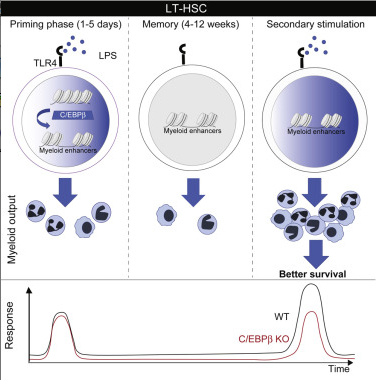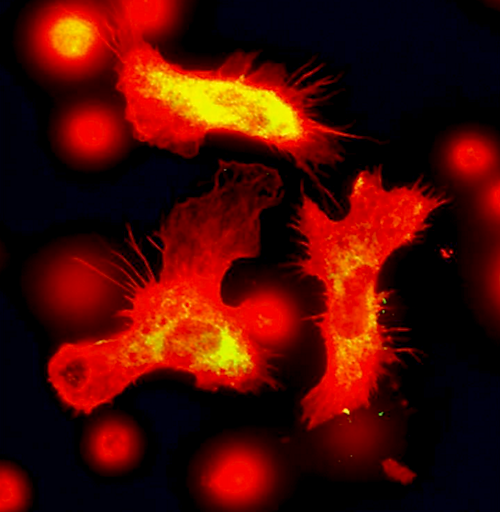|
|
Developmental Biology - Immune System Protection
A Newly Discovered Memory In Our Bones
Our bones' blood stem cells keep a record of all previous infections to boost our immunity...
This finding should have a significant impact on future vaccination strategies and pave the way for new treatments of an underperforming or over-reacting immune system. The results of this research are published in Cell Stem Cell, March 12, 2020.
Stem cells act as reservoirs for future needed cells - as they divide to produce new stem cells, and a myriad of different types of specialized cells, whenever needed to renew tissues.
Commonly called "blood stem cells", hematopoietic stem cells (HSC) nestle in bone marrow, the soft tissue at the center of large bones — such as our hips and thighs. Their role is to renew the repertoire of blood cells and cells of our immune system — which are crucial to fight infection and disease.
Until a decade ago, the dogma was that HSCs are unspecialized cells, blind to external signals such as infections. Only their specialized daughter cells were supposed to sense signals and activate an immune response.
But work from Prof. Michael Sieweke, and other laboratories, in the past few years has proven this dogma wrong. HSCs can actually sense external factors and produce specific subtypes of immune cells "on demand" that can fight infection.
Beyond their role in an emergency immune response, the question remained as to the function of HSCs in responding to repeated infectious episodes. The immune system is known to have a memory that allows it to better respond to returning infectious agents. The present study now establishes a central role for blood stem cells in this memory.
"We discovered HSCs could drive a more rapid and efficient immune response if they had previously been exposed to LPS — a bacterial molecule that mimics infection.
Dr. Sandrine Sarrazin PhD, Department of Immunology, Centre d'Immunologie de Marseille-Luminy, Marseille, France.
"The first exposure to LPS causes marks to be deposited on the DNA of the stem cells, right around genes that are important for an immune response. Much like bookmarks, the marks on the DNA ensure that these genes are easily found, accessible and activated for a rapid response if a second infection by a similar agent was to come."
Michael Sieweke PhD, Professor, Humboldt at TU Dresden, and senior-author of the publication. CNRS Research Director and last author of the publication.
 Blood stem cells remember previous attacksto fight a new infection. Image Credit CELL STEM CELL
The authors further explored how the memory was inscribed on the DNA, and found C/EBPß to be the major actor, describing a new function for this factor, also important to emergency immune responses. Together, these findings should lead to improvements in tuning the immune system or better vaccination strategies.
"The ability of the immune system to keep track of previous infections and respond more efficiently the second time they are encountered is the founding principle of vaccines.
Now that we understand how blood stem cells bookmark immune response circuits, we should be able to optimize immunization strategies to broaden protection from infectious agents.
It could also more generally lead to new ways to boost the immune response when it underperforms or turn it off when it overreacts"
Michael Sieweke PhD, Center for Regenerative Therapies Dresden (CRTD), Technische Universität Dresden, Germany and Max-Delbrück-Center for Molecular Medicine in der Helmholtzgemeinschaft (MDC), Berlin, Germany.
Professor Sieweke's research group is at the interface of immunology and stem cell research. His group studies hematopoietic stem cells and macrophages, the long-lived mature cells of the immune system that play an important role in tissue regeneration.
Siewek also acts as Deputy Director of the Center for Regenerative Therapies Technical University Dresden (CRTD), studying the principles of cell and tissue regeneration for recognition, treatment and reversal of diseases. The CRTD links scientists to clinicians to gene-editing and regeneration of innovative therapies in neurodegenerative diseases such as Alzheimer's and Parkinson's disease; hematological diseases such as leukaemia; and metabolic diseases such as diabetes; as well as retina and bone diseases.
Abstract Highlights
• LT-HSCs conserve epigenetic memory of previous infectious challenge
• Increased transcriptional response of open myeloid enhancers to secondary stimulation
• Memory improves myeloid differentiation and resistance to secondary infection
• C/EBPß is required for LPS-induced memory, but not transient inflammatory response
Summary
Hematopoietic stem cells (HSCs) maintain life-long production of immune cells and can directly respond to infection, but sustained effects on the immune response remain unclear. We show that acute immune stimulation with lipopolysaccharide (LPS) induced only transient changes in HSC abundance, composition, progeny, and gene expression, but persistent alterations in accessibility of specific myeloid lineage enhancers occurred, which increased responsiveness of associated immune genes to secondary stimulation. Functionally, this was associated with increased myelopoiesis of pre-exposed HSCs and improved innate immunity against the gram-negative bacterium P. aeruginosa. The accessible myeloid enhancers were enriched for C/EBP? targets, and C/EBP? deletion erased the long-term inscription of LPS-induced epigenetic marks and gene expression. Thus, short-term immune signaling can induce C/EBP?-dependent chromatin accessibility, resulting in HSC-trained immunity, during secondary infection. This establishes a mechanism for how infection history can be epigenetically inscribed in HSCs as an integral memory function of innate immunity.
Authors
Bérengère de Laval, Julien Maurizio, Prashanth K. Kandalla, Gabriel Brisou, Louise Simonnet, Caroline Huber, Gregory Gimenez, Orit Matcovitch-Natan, Susanne Reinhardt, Eyal David, Alexander Mildner, Achim Leutz, Bertrand Nadel, Christophe Bordi, Ido Amit, Sandrine Sarrazin and Michael H. Sieweke.
Acknowledgements
This study was funded by TU Dresden / CRTD through the German Excellence Initiative, the German Research Foundation as well as through an ERC Advanced Grant from the European Research Council and the Alexander von Humboldt Foundation. The study was further supported by funding from the Institut National de la Sante et de la Recherche Medicale, the Centre National de la Recherche Scientifique, Aix-Marseille University, the Agence Nationale de la Recherche, the Foundation ARC pour la Recherche sur le Cancer, an INSERM-Helmholtz cooperation programme and the Einstein Foundation.
Return to top of page.
|
|
Apr 22 2020 Fetal Timeline Maternal Timeline News
 Immune cells by fluorescence microscopy: Blood stem cells remember a previous attack and produce more immune cells like these macrophages to fight a new infection. CREDIT Sieweke lab/CIML.
|
|

